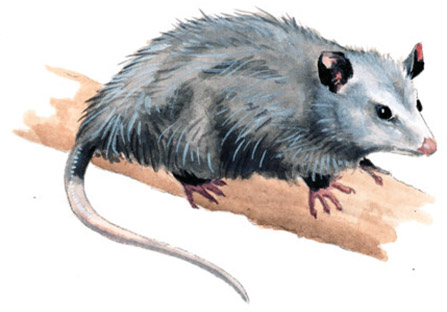

Family Didelphidae (Opossums)
Size: 30" with tail
Range: Central and eastern United States; portions of Pacific states
Habitat: Woodlands, riparian zones, urban areas with trees, farms
The Virginia Opossum is a marsupial, meaning it bears premature young that develop in an external pouch, and is the only member of this group in North America. It is stocky, with relatively small limbs, a pointed snout, and a long, round, hairless tail. Its color is mottled grayish, with a white face and dark ears. It is nocturnal, mostly solitary, and reasonably adept at swimming and climbing. It has a highly varied diet that includes nuts, fruit, insects, small animals, and carrion. Opossums have a curious habit of feigning death when under attack, then resuming as normal once safe.
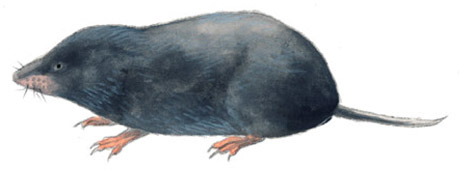
Family Soricidae (Shrews)
Size: 3-5" long with tail
Range: Southeastern United States
Habitat: Moist woodlands, brushy areas
Shrews are the smallest mammals in North America and are unrelated to the rodents. The Southern Short-tailed Shrew is very active. It is shaped like a long mouse, with a sharply pointed head, tiny eyes, no external ears, and a short, lightly furred tail. Its fur is dense, dark gray above and slightly paler below. This shrew is active day and night, mostly solitary, and utilizes an extensive network of tunnels, which it digs itself. Voracious feeders, shrews forage within their tunnels and nearby leaf litter for insects, earthworms, spiders, small invertebrates, and sometimes nuts and seeds. Shrews can also secrete poisonous saliva that paralyzes prey.
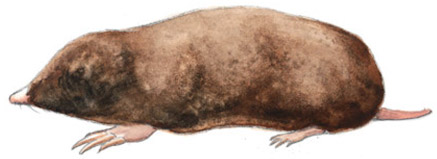
Family Talpidae (True Moles)
Size: 6" long with tail
Range: Central and eastern United States
Habitat: A variety, including fields, woodlands, lawns, and areas with dry, loose soils
Also known as the Common Mole, the Eastern Mole is a small, stocky, sturdy mammal with a body well designed for life underground. It is elongate and tube-shaped, with narrow hips, a pointed, fleshy snout, and a short tail. Its fur is short, velvety, deep gray brown above and slightly paler below. Its eyes are tiny and covered by skin, and its ears are invisible beneath its fur. Eastern Moles build tunnels, which they dig with their broad, spade-like forelimbs and long, thick claws. They forage within the tunnels for earthworms, insects, and some plants. Eastern moles are responsible for creating conspicuous dirt mounds at the entrances to their tunnels.
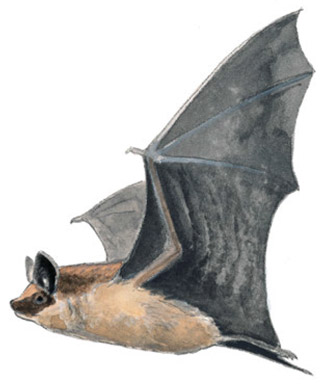
Family Vespertilionidae (Vespertilionid Bats)
Size: 5" with tail
Range: Throughout the contiguous United States
Habitat: A wide variety, including woodlands, buildings, and caves
As a group, bats are the only mammals that truly fly, using wings made of a thin membrane stretched across elongate forearms and fingers. The Big Brown Bat is widely distributed. It is fairly large, with fur that is brown above and lighter below, with blackish wing membranes. There is a fleshy projection at the base of the ear (the tragus), which is short and rounded. Big Brown Bats are nocturnal, roosting by day in dark, secluded areas such as caves or old buildings. They emerge at night to forage for beetles and other insects, locating them primarily by echolocation, emitting high-pitched chirps and receiving reflected sound with their complex, large ears.
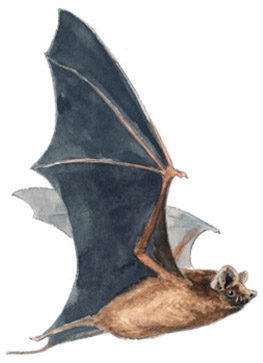
Family Molossidae (Free-Tailed Bats)
Size: ~4" with tail
Range: Throughout the contiguous United States
Habitat: Caves, buildings, and surrounding environs
Also known as the Mexican Free-tailed Bat or Guano Bat, the Brazilian Free-tailed Bat is small, with narrow wings and a tail that projects freely about halfway past the interfemoral membrane, a patch of skin that stretches between the legs. Its fur is rich brown, slightly darker above than below, and its wings are blackish. The ears are broad, reaching forward on the face, and the upper snout is wrinkled. Brazilian free-tailed bats emerge from roosting sites at night in large groups and forage in the air for a variety of insects, using echolocation to zero in on prey. These bats are among the most numerous mammals in the United States, famous for gathering in enormous concentrations in caves in New Mexico and for depositing deep accumulations of guano in those caves.
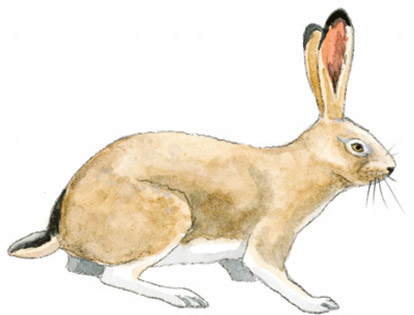
Family Leporidae (Rabbits and Hares)
Size: ~23" long
Range: Western United States
Habitat: Prairies, open sage land, meadows
The black-tailed jackrabbit is a large, lanky hare with relatively long legs and huge, black-tipped ears. The color is gray brown, paler underneath, with a white tail that has a black stripe on top that extends onto the rump. The similar white-tailed jackrabbit has no dark upper surface on the tail and inhabits the mountains of eastern California. Jackrabbits are mostly nocturnal and solitary, highly alert, and able to elude predators with exceptionally fast runs and high jumps. They forage on grass and other vegetation, but may be limited to bark and buds in winter.
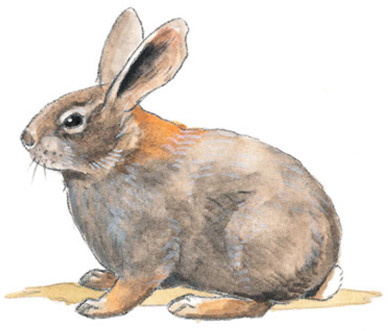
Family Leporidae (Rabbits and Hares)
Size: 15" long
Range: East of the Continental Divide
Habitat: Open woodlands, areas near water, dense brush
The Eastern Cottontail is colored gray brown to reddish brown, with a short, rounded, white tail (hence the common name). Its eyes are quite large, and its rear feet are long and powerful. Like other rabbits, they are an important food source for most carnivorous wildlife. Eastern Cottontails are mostly nocturnal, but can be seen feeding at almost any time for grasses, herbs, branches, and bark. They never stay too far from brushy cover or their burrows. They are almost identical to the Desert Cottontail of western states, but are a bit larger with proportionately smaller ears.
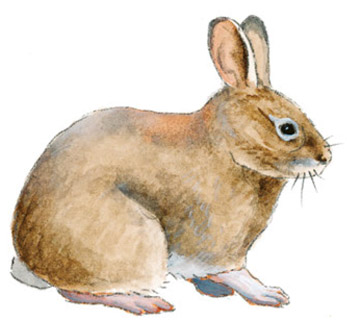
Family Leporidae (Rabbits and Hares)
Size: 13"
Range: Pacific United States
Habitat: Dense, brushy areas
The Brush Rabbit is a smaller version of the desert cottontail, with a preference for thick brush in which to hide. Its fur is coarse; the color is brownish gray overall. Its ears are relatively small, and the tail is grayish brown and inconspicuous, unlike the white of the cottontail. Brush Rabbits are secretive, foraging mostly during the night on all matter of vegetation, including twigs, grasses, bulbs, tubers, and leaves. As a defense they remain motionless, or run for the cover of brush, tunnels, or trees, and may be heard thumping their hind legs on the ground.
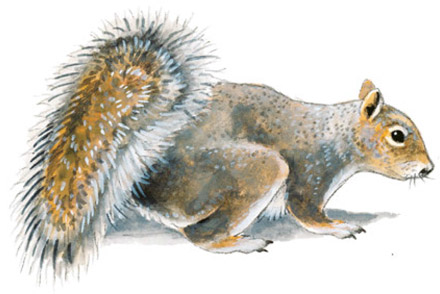
Family Sciuridae (Squirrels)
Size: 18" with tail
Range: Pacific United States
Habitat: Mixed hardwood forests, parks, suburbs
The widespread and common Western Gray Squirrel, also known as the California Gray Squirrel, is social, arboreal, and relatively large. It has a long, very bushy tail and large eyes. Its color is gray, sometimes with a brownish cast, and whitish below, with pale eye rings. Its tail is edged with white-tipped hairs. Active most times of the day, these squirrels forage for nuts, fruits, seeds, insects, eggs, and fungi, and may store nuts in ground caches. Ubiquitous in rural yards and parks, they use tree cavities to nest in or may build large nests of twigs and leaves high in a tree.
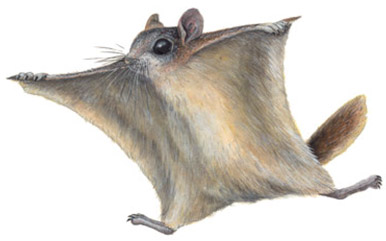
Family Sciuridae (Squirrels)
Size: 16" with tail
Range: Northern United States
Habitat: Coniferous or deciduous woodlands, oak stands
The Northern Flying Squirrel is small and unusual, designed to glide (not fly) from tree to tree or from tree to ground. Flaps of skin connect the front and rear feet; when outstretched, these flaps allow the squirrel to glide more than 100 feet and make a delicate landing. The color is grayish brown, darker along the flanks, and whitish below. These squirrels are active at night and are highly social, with several individuals sometimes sharing a nest site in a tree cavity or external structure. They forage for nuts, fruit, insects, fungus, and eggs and store food in tree cavities for winter use.
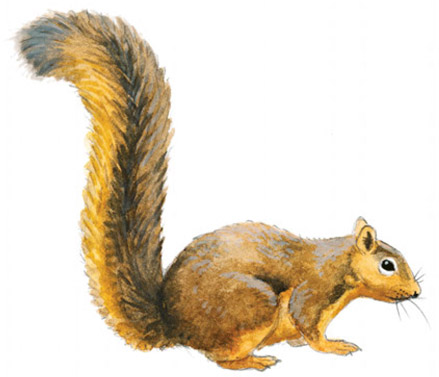
Family Sciuridae (Squirrels)
Size: 24–30" long with tail
Range: Central and eastern United States
Habitat: Open, mature woodlands
The Eastern Fox Squirrel is a large tree squirrel with a long, bushy tail. It occurs in variable color morphs: The body can be rusty brown to grayish to all black above, with the underside whitish or tawny. In Colorado the fox squirrel is usually reddish brown on the back and sides and pale orange on the belly, face, and legs. Eastern Fox Squirrels are generally solitary, searching in trees or on the ground for nuts, buds, and berries. In the fall, they cache nuts in tree cavities or in large nests in the crotches of trees, which the squirrels construct from leaves.
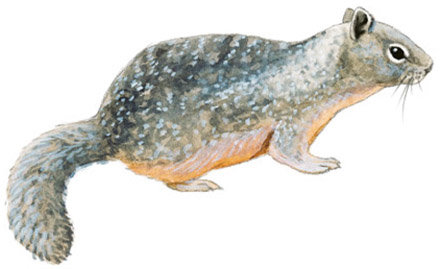
Family Sciuridae (Squirrels)
Size: About 18" with tail
Range: Western United States
Habitat: Fields, open woodlands, rocky area
The California Ground Squirrel is fairly common in open spaces throughout the far western states. These squirrels are of medium length with bushy tails. The fur is speckled in shades of brown, gray, and white, with a darker, forward-pointing V-shaped patch along the back and whitish patches along the sides to the base of the neck. The underside is paler, there are prominent white eye rings, and the tail is mottled or striped in the body colors. These squirrels are active during the day, sunning themselves or foraging for a wide variety of food, including nuts, seeds, berries, roots, and insects. They form loose colonies with extensive burrow systems, which they excavate, and each individual has its own entrance, to which it will retreat to when in danger.
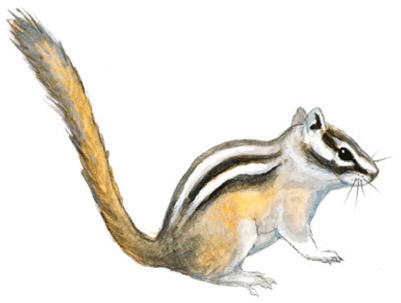
Family Sciuridae (Squirrels)
Size: ~8" with tail
Range: Western United States
Habitat: Arid, high-elevation open forests to lowland sagebrush and rocky areas
The smallest chipmunk in North America, but similar in body shape to other chipmunks, the Least Chipmunk has a small body, large head and eyes, and a long, bushy tail. The most obvious field marks are the white-and-dark brown stripes across the head and along the back. Much geographical variation exists, but typically the Least Chipmunk’s sides are orange-brown, the underparts are pale gray, and the tail is mottled in the body colors, often striped with black near the base. The chipmunk usually holds its tail in a vertical position when running. Least Chipmunks are active during the day from spring to fall, busily collecting nuts, berries, grasses, and insects, using an extendable cheek pouch to carry extra food for storage. They nest in burrows, under logs, or in trees and spend the winter in partial hibernation underground, where they periodically awaken to nibble on bits of cached food. These chipmunks often visit campsites for food and can be quite vocal, emitting a high-pitched chip. The similar Colorado Chipmunk is larger, with longer stripes on the back.
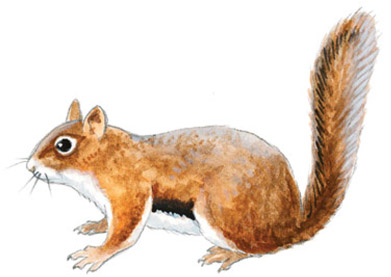
Family Sciuridae (Squirrels)
Size: ~12" long with tail
Range: Northeastern United States, intermountain west
Habitat: Coniferous or mixed woodlands
The Red Squirrel, also known as the Pine Squirrel and the Chickaree, is feisty, highly territorial, and most at home in trees. It is relatively small, with a bushy tail and large eyes encircled with white. The color is reddish brown above and white below, with a dark band in between. These squirrels may be somewhat paler in winter months. They are primarily active during the day and at all times of the year. They eat the nuts of pine and spruce cones, but they will also eat berries, insects, and mushrooms.
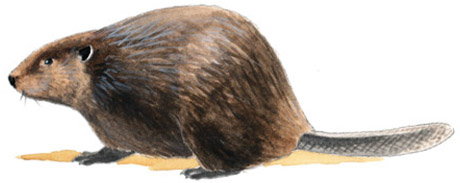
Family Castoridae (Beavers)
Size: 28" body; 10" tail
Range: Throughout the United States
Habitat: Ponds, lakes, streams with adjacent woodlands
Once nearly extirpated because of hunting and trapping for pelts, this largest of North American rodents now covers most of its original range. The beaver is heavy and compact, with webbed rear feet, large front incisors, and a long, dexterous, scaled, flattened tail. The color is dark brown. Beavers are known for cooperative construction of impressive dams and lodges made from trees they have felled. Their presence is often announced by loud tail slaps on the water. Mostly nocturnal, beavers eat the tender, inner bark of trees, as well as small branches and buds.
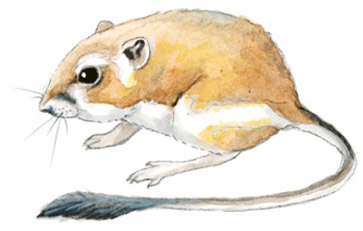
Family Heteromyidae (Pocket Mice, Kangaroo Mice, and Kangaroo Rats)
Size: ~ 4" body; 5½" tail
Range: Inland western United States
Habitat: Lowland prairies and scrublands with sandy soils
One of several species of kangaroo rats across the arid west, the Ord’s Kangaroo Rat occupies the largest range and is one of the smaller varieties. It is a compact rodent with a relatively large head, a long tail with a bushy distal portion, and oversize rear feet, akin to a kangaroo. Its color is buff to rusty brown, with white lateral stripes across the lower body and the middle of the tail. Mostly nocturnal and somewhat solitary, kangaroo rats spend the day in their burrows. They hop about, kangaroo-style, foraging for plants, seeds, and insects. They are well adapted to dry conditions and receive most of the water they need through their food.
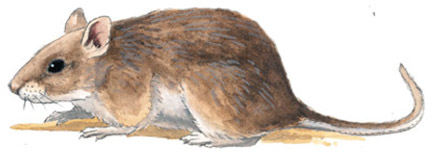
Family Cricetidae (New World Mice and Rats)
Size: 21" long with tail
Range: Eastern and central United States
Habitat: Grasslands, woodlands, rural buildings
The Eastern Wood Rat is a chunky, large rodent with a squarish head, large ears, and hairy tail that is usually slightly shorter than its body. The fur is grayish brown above, with white below and on the feet. Eastern Wood Rats are nocturnal, breed year-round, and feed on plant matter and seeds, as well as fungi. They build house-like nests of sticks and debris in crevices, burrows, or caves, which offer protection and a place to cache food. They are members of the “pack rat” group, known to collect bits of small metallic refuse.
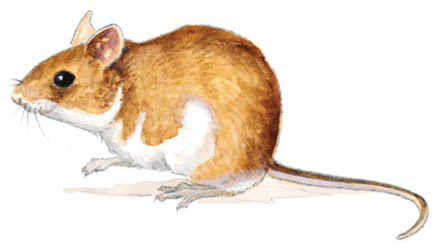
Family Cricetidae (New World Mice and Rats)
Size: 4" body; 3" tail
Range: Throughout the United States except for the far south
Habitat: Highly variable: grasslands, woodlands, mountains, brushlands
The Deer Mouse is common and widespread. It occurs in a wide range of habitats, and can vary in size and color depending on region. The appearance is typical of the mice, with a small body, pointed snout, large, black eyes, and large ears. The tail is thin and varies in length, but is typically slightly shorter than the body. Color ranges from grayish to brown or orange-brown above, with a white underside and lower part of the face. The tail is dark above, sharply contrasting with white below. Deer Mice are most commonly active during the night, emerging from daytime refuges of burrows or under rocks and stumps. They scamper along the ground, in brush, or in trees gathering nuts, fruits, grasses, and insects. They store extra food to eat during lean winter months in a hidden cache, since they do not hibernate.
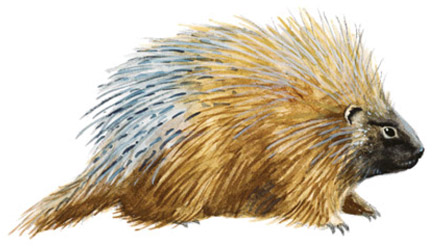
Family Erethizontidae (Porcupines)
Size: ~28" with tail
Range: Western and far northeastern United States
Habitat: Forests, thickets
The Porcupine is a primarily arboreal, chunky, lackadaisical rodent with small limbs, a bushy tail, and thousands of pointed barbed quills, which serve as its only defense. Its color is dark brown to blackish. Found alone or in groups, the Porcupine is mostly nocturnal but can be seen at all times of the day, often perched in trees. Porcupines feed on all types of plant matter, including buds, branches, bark, roots, and leaves.
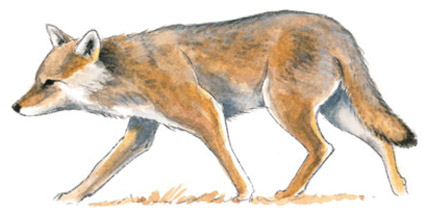
Family Canidae (Coyotes, Wolves, and Foxes)
Size: 4' with tail
Range: Throughout most of the United States except the southeastern region
Habitat: Open country, scrub, grasslands
The Coyote is an intelligent and adaptable canid that has been able to survive in a wide variety of habitats and in spite of persecution by humans. It looks like an average-size dog, with a long, thin muzzle and pointed ears. The color can range from gray to light brown or reddish. It has a bushy tail that is held low or between the legs. Coyotes hunt alone or in small packs, primarily during the night. Their diet is varied, and they scavenge for anything edible, including rodents, rabbits, snakes, berries, insects, and carrion.
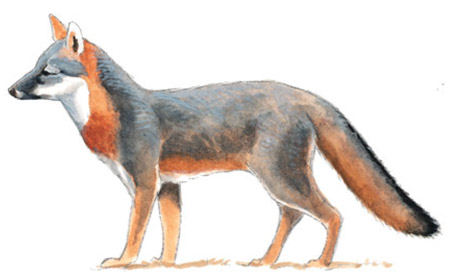
Family Canidae (Coyotes, Wolves, and Foxes)
Size: 3' with tail
Range: Throughout most of the contiguous United States except parts of northwestern and north-central states
Habitat: Open woodlands, brush, suburban areas
The Gray Fox is a small, stealthy, nimble canid with a bushy tail and the ability to climb trees using its short, curved, retractable claws. Its fur is gray and white speckled above and reddish along the sides and legs, and there is a black streak down the back and tail, ending in a black tail tip. Its muzzle is thin and small, while its ears are comparatively large. Gray Foxes are mostly solitary and nocturnal and feed on a varied diet that includes rabbits, rodents, insects, nuts, and fruit.
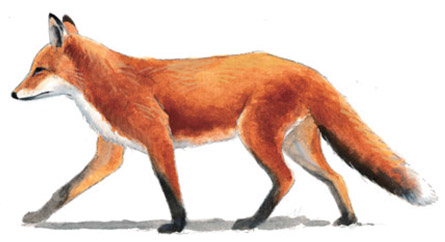
Family Canidae (Coyotes, Wolves, and Foxes)
Size: 38" with tail
Range: Throughout most of the contiguous United States; Alasks
Habitat: Open woodlands, fields, brushy areas; may approach urban centers
Like other foxes, the Red Fox is wily, secretive, adaptable, and dog-like. It has a small muzzle, large ears, and a bushy tail. It is rusty red above, white or gray below, with black “stockings” on its legs and a white-tipped tail. Color variations may include black or slate gray, and the fox may have a dark cross along the shoulders. Red Foxes are solitary hunters and are most active at night or in the twilight hours, seeking the shelter of a den during the day. They feed on small mammals, insects, carrion, plants, and berries, sometimes performing a dramatic leaping pounce to catch rodents.
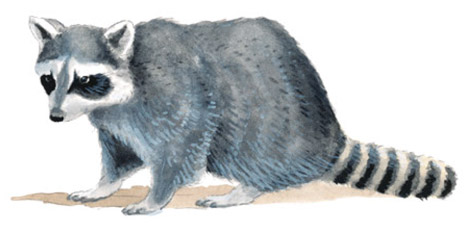
Family Procyonidae (Ringtails and Raccoons)
Size: 34" with tail
Range: Throughout most of the contiguous United States
Habitat: Woodlands, streams or lakesides, urban areas
The Raccoon is a highly adaptable mammal, equally at home in remote forests or urban centers. It is stocky and heavy, with a short, masked face and a bushy coat. Its color is pale gray mixed with black, with a tail ringed in black and gray. Incredibly dexterous fingers allow it to undo knots and even work doorknobs. Raccoon are primarily nocturnal and may be seen alone or in small groups. They prefer to feed near a water source, often dipping their food in water first, and will eat just about anything, including fruit, nuts, insects, fish, crayfish, and worms.
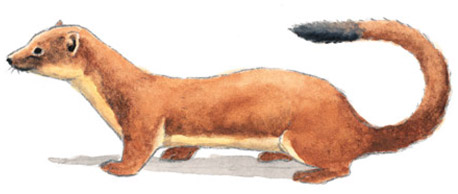
Family Mustelidae (Weasels and Otters)
Size: 14" with tail
Range: Throughout the contiguous United States
Habitat: Woodlands, fields with brushy cover, often found near water
The Long-tailed Weasel is a wily, small, elongate, long-necked predator and one of North America’s smallest meat eaters. It is reddish brown, with buff-colored underparts and throat, and has a black tip on its long tail. The weasel is nocturnal and solitary, is an excellent climber, and, due to its thin, sinuous shape and short legs, can slip into burrows to attack rodents living within. Long-tailed Weasels also hunt rabbits, birds, eggs, and fish. To den, they use the existing burrows of similar-size rodents.
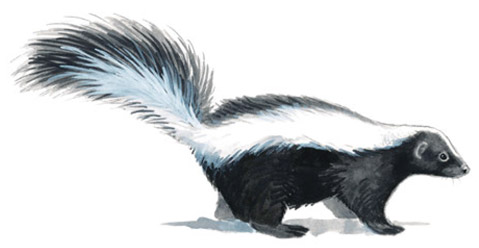
Family Mephitidae (Skunks)
Size: 22" with tail
Range: Throughout the contiguous United States
Habitat: Woodlands, brush, suburban parks; usually near a water source
The Striped Skunk is known primarily for its ability to elude danger by spraying a noxious fluid from an anal duct. It is a stocky, weasel-like mammal with a long, bushy tail and long front claws for digging. Its color is black, with broad white stripes running down its sides that merge into a white stripe on the upper part of the tail. Usually solitary, Striped Skunks stay in dens during the day and forage at night. Being omnivorous, they eat a wide variety of foods including fruit, nuts, insects, small mammals, and eggs.
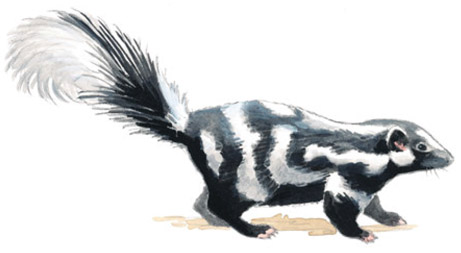
Family Mephitidae (Skunks)
Size: 18" with tail
Range: Western United States
Habitat: Brushy open woodlands, coastal scrub, grasslands; usually near a water source
The Western Spotted Skunk is smaller than the Striped Skunk but shares its defensive ability to spray a noxious liquid from ducts near its anus. It is weasel-like, with fine soft fur, a thick bushy tail, and long claws. Its color is black, with variable and irregular white spotting and striping on its head and back, and it has a white-tipped tail. Solitary and nocturnal, these skunks stay in dens during the day. They can climb trees but mostly forage on the ground, eating a variety of foods, including fruit, insects, small mammals, birds, and eggs. The very similar Eastern Spotted Skunk lives east of the Rocky Mountains.
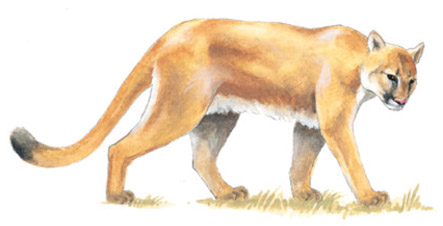
Family Felidae (Cats)
Size: 7' body; 2½' tail (males larger than females)
Range: Western United States; western Gulf states; Florida
Habitat: Open to dense woodlands, brush
The Mountain Lion (also known as the Cougar or Puma) is a huge (about 125 pounds), reclusive, powerful cat. It has a long tail, and its fur is a blend of tawny browns, tans, and grays, paler on the underside and white on the chest and throat. The tail tip is dark brown, as are the backs of the ears and marks on the muzzle. Mountain Lions are mostly solitary, except during breeding season or when mothers are with kittens. They hunt by stealth, waiting on rocky ledges or in trees for prey to pass or slinking through grass to ambush prey, which includes deer, elk, and smaller mammals.
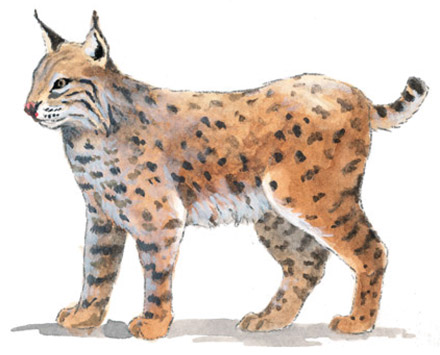
Family Felidae (Cats)
Size: 28" body; 5" tail
Range: Throughout most of the contiguous United States except for parts of the east-central region
Habitat: A wide variety of habitats, including forests, riparian areas, scrub
The Bobcat is about double the size of a housecat, is well camouflaged, and has a very short “bobbed” tail. Its face appears wide due to long fur tufts below its ears, and the ears are tipped with short black hairs. The color is light brown to reddish above, pale or whitish below, and spotted with dark brown or black that sometimes is streaked on the animal’s legs. The tail is striped and black along the top edge. Bobcats are typically active during the early morning and after dusk; in winter they are active during the day. They hunt by stealth, ambushing their favored prey of rabbits, other small mammals, and birds. The similar lynx is a bit larger and has an all-black tail.
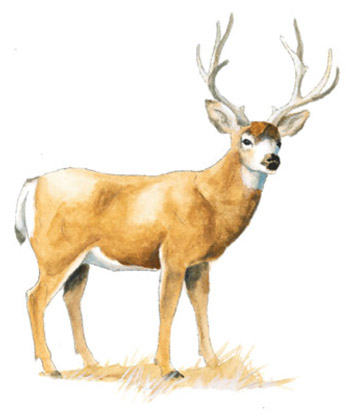
Family Cervidae (Deer, Elk, and Moose)
Size: 6' long with tail (males larger than females)
Range: Central and western United States
Habitat: Quite variable; forests, chaparral, bushy grasslands
The Mule Deer is quite common throughout its range and so-called because of its very large mule-like ears. Its color is gray brown in winter, rusty brown in summer, with a white throat, muzzle, and belly. Depending on the region, its tail may have a black tip or may have black on the top surface. Males have antlers that are evenly forked (not with tines from a central beam, as in the white-tailed deer). In summer the antlers are covered in velvet. Mule deer are active at twilight, moving in small groups or singly and browsing for tree branches, grasses, and herbs.
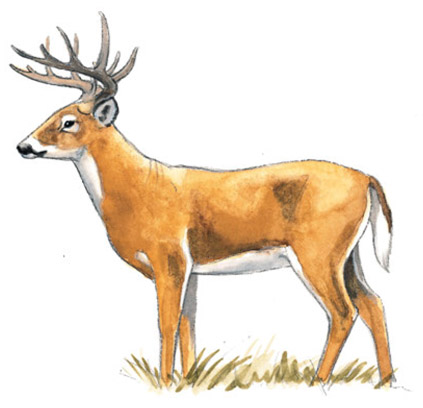
Family Cervidae (Deer, Elk, and Moose)
Size: 6' body; 10" tail
Range: Most of the contiguous United States except for much of California, Nevada, and Utah
Habitat: Dense forest, forest edges
North America’s smallest deer, the White-tailed Deer is a secretive mammal of thick forests. It is very agile, fast, and able to outmaneuver most predators. The male has antlers with a main beam that supports smaller prongs. The color of its fur is reddish brown, with a white belly and throat. When alarmed, the White-tailed Deer raises its tail, revealing the brilliant white underside, hence its colloquial name of “flagtail.” White-tailed Deer travel in small groups in summer, but in winter they may congregate in larger herds. Being herbivores, they forage for grasses, herbs, and nuts.